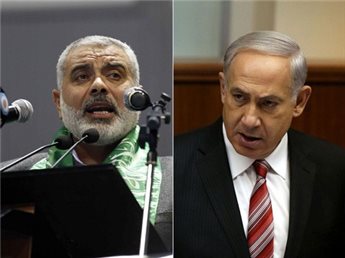Many Israelis are already wondering how they going to deal with at least three more years of an anti-Israel administration in Washington. In general, these are the people who think that pressuring Israel to meet its obligations under the roadmap of June 2003 is empowering the Arabs and weakening the country.
One such person, who defined himself to me as pro-peace, told me that until the Arabs recognise Israel as the Jewish state, freezing settlements sends the wrong message; it tells the Arabs they don’t have to do anything and that all of the pressure will only be on Israel.
But the government knows that it is obligated to the roadmap, which states quite explicitly it must “immediately dismantle settlement outposts erected since March 2001… and consistent with the Mitchell Report, freeze all settlement activity (including natural growth of settlements).”
True, in May 2003 the government of Ariel Sharon issued fourteen reservations to the roadmap. But the United States never accepted them, except for what appears to be an unwritten understanding between Sharon (whose second stroke and coma led to his replacement by Ehud Olmert in January 2006) and then president George W Bush regarding the growth of the settlement blocs in the West Bank and in Jerusalem. But the Bush administration has gone, and with it (as the US secretary of state, Hillary Clinton, has indicated so clearly) those unwritten understandings.
A fine interpretation
But why all the fuss anyway? Who really cares about a few more houses and school classrooms in settlements? Well, the whole world. At the time of the Oslo accords (from September 1993), the world – including the Arab world, and the supporters of peace in Israel and in Palestine – actually believed that the peace process was about ending the occupation. The heart of it was peace between two states living side-by-side, building cross-boundary cooperation in every field possible, ending violence and the conflict as a whole.
During those optimistic days, several countries established diplomatic relations with Israel. Some Arab states even allowed Israel to open commercial-interests offices on their territory, and in turn opened representative offices in Israel. All this was possible because they believed the Oslo peace process would bring an end to the occupation.
They had good reason for the belief. The Israeli-Palestinian interim agreement of September 1995 statedclearly: “The two sides agree that West Bank and Gaza Strip territory, except for issues that will be negotiated in the permanent status negotiations, will come under the jurisdiction of the Palestinian Council in a phased manner, to be completed within 18 months from the date of the inauguration of the council.” The agreement further stated: “Redeployments of Israeli military forces to specified military locations will commence after the inauguration of the council and will be gradually implemented.”
The interpretation of these sections was that prior to the beginning of permanent-status agreements, Israel would have withdrawn from more than 90% of the West Bank. The United States and the Palestinian calculated then that the land area connected to permanent-status negotiations (meaning the settlements) accounted for 2%-5% of the West Bank (counting the built-up areas of the settlements with a radius of about 100 metres from the last home in each settlement). The “specified military locations” were estimated to compose about a further 2% of the West Bank.
A new pressure-point
When Binyamin Netanyahu was first elected in May 1996, a “conflict” of interpretation developed between the prime minister’s office and the foreign ministry. At that time I saw a document produced by the foreign ministry’s legal department . It explained that the new interpretation of these matters being proposed by the prime minister’s office was, on two grounds, incorrect.
First, this interpretation held that the settlement areas in question are based on the statutory planning-maps of the civil administration and not on the built-up areas; and that these zoning-maps provide the settlements with about 40% of the West Bank.
Second, the prime minister’s office stated that the real intention now was to define “security zones” rather than “specified military locations”. This meant in effect that the entire Jordan valley is a security-zone; all of the areas around settlements are security-zones; the bypass roads to settlements are security-zones; and so are all of the lands adjacent to the green line. The implication was that well over half of the West Bank would remain in Israeli hands.
The Palestinians and even the US regarded this interpretation as a major breach of the agreement. It was one of the significant reasons for the failure of the entire process. No wonder, for at that point the process ceased to be about ending the occupation and instead became about how emasculated the Palestinian entity would be (see Avi Shlaim, “Israel at 60: the ‘iron wall‘ revisited“, 8 May 2008).
Ehud Barak, who became prime minister in succession to Netanyahu in May 1999, understood that he would have a very tough negotiation on the territorial question. When I asked his chief-of-staff Gilead Sherwhy the prime minister was building even more settlements than Netanyahu, his answer was “the story of the goat” – meaning that it would later create the appearance that Israel was making larger concessions than was really the case.
Ariel Sharon shared with other Likud leaders the consistent belief that the settlements would be the best way of preventing the establishment of a Palestinian state in the West Bank. It turns out that they were probably right. Many today cite the settlements to question the very viability of a Palestinian state.
Yet the entire international community – with the exception of Iran, Libya and perhaps Israel – believes that a Palestinian state must be established on the basis of the 4 June 1967 borders. There is no other solution to the conflict. Instead of dealing with that reality, Binyamin Netanyahu’s second government today (with Ehud Barak as defence minister) is trying to pressure the US and the European Union to transform the peace process into a regional peace process.
A turning-point
Binyamin Netanyahu, Ehud Barak and other members of the government think that if they agree to a three-month settlement freeze (not including Jerusalem) the world will consent. The European Union and the United States, in private meetings with the prime minister and in public statements, have insisted that Israel must focus on the settlement issue and not on tricks to avoid making the difficult decisions. All settlement building must stop, is the message.
From the standpoint of moving forward with the peace process, this is no more than a tactical issue – since even a full settlement freeze will change nothing on the ground. But it does have strategic consequences. The settlement freeze is meant to be an indication that Israel has accepted the principle that the occupation must come to an end. Only then will it be really possible for the rest of the Arab world to consider how to phase in the normalisation of relations, as they began to do with the outset of Oslo.
It will be objected that Judea and Samaria are Israel’s historical, religious and national lands, and that the argument is not about Israel’s right to be there, whether the world accept that right or not. But the reality is that there is no other way for Israel to achieve peace with its neighbours. There is global consensus on this issue and continued objection will only increase Israel’s isolation.
Boycott, sanctions and divestment are right around the corner. The international community knows that it worked over South Africa and that it will work against Israel as well. It is time to wake up and face reality. Israel still can – with the help and understanding of the world, led by President Barack Obama – develop a peace process that is based on real security and real peace. But it must recognise that there are no short cuts, by signalling that the occupation will come to an end and then beginning to act accordingly.


